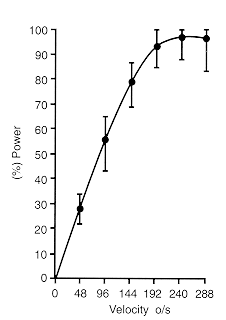| |
Coupling
to the Machine
The arms and the legs provide ways of coupling the human
machine to the device to be propelled. Evolution has caused the muscle mass
of the legs to be larger than that of the arms and they are, therefore, the
best choice for vehicle propulsion. In as much as the oxygen required for sustained
work output must be supplied by the blood circulation, and heat removal
to the skin employs this same route, there is not any substantial advantage
to using arms and legs together in a propulsion situation.
Muscles
extend or contract and cause the flexing of a joint such as the knee or elbow.
The power output of the limb is dependent upon the angular flexing rate of the joint as shown in the diagram for the knee. The data represented is the
average from 15 subjects and suggests that the power output plateaus at flexing
rates above 2400/sec. In designing a device to couple human work
output into a propulsion system this biological limit must be considered. |
|
|
|
|
|
|
|
|
|
|
|
|

